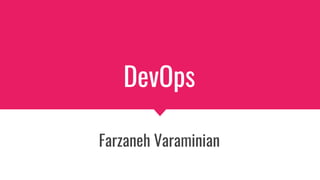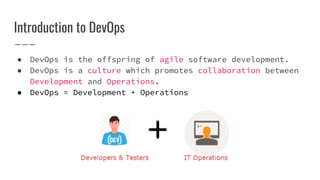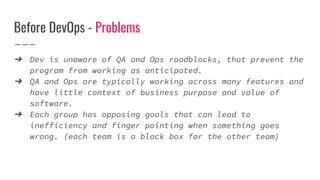Dev ops
- 2. Introduction to DevOps â DevOps is the offspring of agile software development. â DevOps is a culture which promotes collaboration between Development and Operations. â DevOps = Development + Operations
- 3. Models before DevOps â Waterfall Model â Agile Methodology DevOps grows out of the agile software development movement
- 4. Before DevOps - Waterfall â Long planning phases â Sequential â Top-down approach â Linear â A lot of time to produce the product â The working software was delivered only after the final phase â Suitable for projects with stable requirements. (Requirement will no change by the time)
- 5. Before DevOps - Waterfall
- 6. Before DevOps - Agile Methodology â Continuous Iteration of development and testing â Development and testing are concurrent â Lack of collaboration between developers and operations
- 7. Before DevOps â Development Team (Dev) â Quality Assurance Team (QA) â Operations Team (Ops)
- 8. Before DevOps - Development Team â Gathering business requirements for a software program and writing codes. â Ship as many features as possible.(Speed)
- 9. Before DevOps - Quality Assurance Team â Test the program in an isolated environment. â Find as many bugs as possible.
- 10. Before DevOps - Operations Team â Stability of Application â Deploying â Networking â Database operations
- 11. Before DevOps - Problems â Dev is unaware of QA and Ops roadblocks, that prevent the program from working as anticipated. â QA and Ops are typically working across many features and have little context of business purpose and value of software. â Each group has opposing goals that can lead to inefficiency and finger pointing when something goes wrong. (each team is a black box for the other team)
- 13. Development & Operations - Opposing Goals Development Speed Operations Stability
- 14. DevOps Goals â Fast Time To Market â Few production failures â Immediate recovery from failures Development & Operations Speed & Stability
- 15. With DevOps â Happier Teams â Tech employees tend to be happier doing devops than doing traditional silos â More time to innovating â Devs donât feel like they have to fight to get their work out there â Operation people donât have to fight devs for stability â Happier Customers â Give customers the features they want quickly â Use more stable Applications
- 16. What is DevOps? DevOps is the practice of operations and development engineers participating together in the entire service lifecycle, from design through development process to production support.
- 17. Why DevOps?
- 18. When to adopt DevOps? It should be used for large distributed applications: â eCommerce sites â Applications hosted on a cloud platform
- 19. When not to adopt DevOps? It should not be used in a mission-critical application, which it need strict access controls on production environments: â Bank â Power â Sensitive data sites
- 21. DevOps Life Cycle: Continuous Development â Planning â Understanding the vision of project â Envisioning a software based on perceptions â Software Coding â Developing the source code â Maintaining the code (SCM) â Version Control tools: Subversion, Git â Packaging â Producing .exe, jar, war files â Using Maven, Gradle
- 22. DevOps Life Cycle: Continuous Integration â The core of entire life cycle. â Frequently merging code changes done by developers. â Developers run tools for unit testing, code review, integration testing. â Early reflection of end-users to the updated code. â Tool for procuring the updated source code and constructing to the build formate: Jenkins
- 23. DevOps Life Cycle: Continuous Testing â Continuously testing of developed software for bugs. â Automation testing Tools: Selenium, JUnit, TestNG â Using Docker containers to simulate the test environment. â Automation testing saves the time.
- 24. DevOps Life Cycle: Continuous Deployment â Here Code is deployed to the production server. â Configuration Management: Precise deployment of code on all servers â Tools used: Ansible, Puppet, Chef â Code is released to servers, Updates are scheduled for servers â Containerization Tool: Maintaining consistency across the environment where the application deployed. â Tools used: Docker, Vagrant
- 25. DevOps Life Cycle: Continuous Monitoring â Continuously monitor the performance and stability of application â Vital information about the use of software like â Memory usage (âlow memoryâ error) â Cpu â Disk I/O â Application log â Network traffic â Other resources over time â Increasing the productivity and reliability of the system â Tools: Sensu, ELK stack, New Relic
- 26. Continuous Monitoring: Why do Monitoring? â Fast Recovery â The sooner a problem detected, the sooner it can be fixed â Better root cause analysis â The more data you have, the easier it is to determine the causes â Visibility across the teams â Give useful data to both developers and production people about the performance of code in production. â Automated response â Monitoring data used alongside orchestration to provide automatic responses to events and recovery from failures
- 27. Thank You.


























